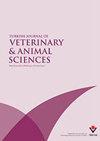为建立土耳其孵化场和食用蛋沙门氏菌国家控制方案奠定基础
IF 0.5
4区 农林科学
Q4 VETERINARY SCIENCES
引用次数: 2
摘要
沙门氏菌引起的食源性感染仍然是世界范围内的一个主要问题。特别是受污染的鸡蛋和鸡蛋相关产品是人类沙门氏菌病的主要来源。有必要确定鸡蛋从农场到餐桌和环境范围内沙门氏菌污染的相关危险因素。本研究的目的是制定“国家蛋鸡沙门氏菌控制计划”,报告土耳其蛋鸡和鸡蛋中沙门氏菌的流行情况和血清型分布结果。在分离和鉴定程序后,根据ISO 6579:2002,共收集和分析了2122个样品。对2015 - 2017年分布在9个不同省份的241个流行病学单位疫区的726只鸡蛋和1396份农场标本进行血清分型。241个epu中有14.9%检出沙门氏菌污染。结果表明,近半数鸡群存在多重污染源。环境污染率最高,为11%,粪便次之,为7.5%,水样污染率最低,为1.6%。总体污染率为7.46%的农场和3.3%的鸡蛋。由于肠炎沙门氏菌和鼠伤寒沙门氏菌是世界上最常见的血清型,土耳其未检出鼠伤寒沙门氏菌,肠炎沙门氏菌是第5常见的分离血清型。根据我们的结果,可以得出结论,不同国家,特别是地理和鸡蛋孵化系统的差异可能会影响沙门氏菌的污染率和血清型分布。本文章由计算机程序翻译,如有差异,请以英文原文为准。
Base study for the establishment of national Salmonella control program in hatching farms and table eggs in Turkey
Foodborne infections due to Salmonella are still a major concern worldwide. Particularly contaminated egg and egg related products are the primary sources for human salmonellosis. It is necessary to determine the risk factors associated with Salmonella contamination of eggs within the scope of farm to table and environment. The objective of this study was to develop the "National Salmonella Control Program in Laying Hens" and report the prevalence and serotype distribution findings of Salmonella in laying hens and eggs in Turkey. A total of 2122 samples were collected and analysed according to ISO 6579:2002 after the isolation and identification procedures. All Salmonella isolates were serotyped including 726 eggs and 1396 farm specimens from 241 epidemiological units EpUs that were located in 9 different provinces between 2015 and 2017. Salmonella contamination was detected in 14.9% of 241 EpUs. The results indicated that almost half of the flocks have multiple contamination sources. The highest contamination rate was obtained from environmental 11% followed by faeces 7.5% and the lowest was from water samples 1.6% . The overall contamination rate was detected as 7.46% for farms and 3.3% for eggs. As S. Enteritidis and S. Typhimurium are the most frequently seen serotypes all over the world, in Turkey S. Typhimurium was not detected and S. Enteritidis was the 5th most common isolated serotype. According to our results it can be concluded that differences in various countries, particularly geographical and egg hatching systems, may affect the contamination rate and serotype distribution of Salmonella.
求助全文
通过发布文献求助,成功后即可免费获取论文全文。
去求助
来源期刊
CiteScore
1.30
自引率
0.00%
发文量
57
审稿时长
24 months
期刊介绍:
The Turkish Journal of Veterinary and Animal Sciences is published electronically 6 times a year by the Scientific and Technological Research Council of Turkey (TÜBİTAK).
Accepts English-language manuscripts on all aspects of veterinary medicine and animal sciences.
Contribution is open to researchers of all nationalities.
Original research articles, review articles, short communications, case reports, and letters to the editor are welcome.
Manuscripts related to economically important large and small farm animals, poultry, equine species, aquatic species, and bees, as well as companion animals such as dogs, cats, and cage birds, are particularly welcome.
Contributions related to laboratory animals are only accepted for publication with the understanding that the subject is crucial for veterinary medicine and animal science.
Manuscripts written on the subjects of basic sciences and clinical sciences related to veterinary medicine, nutrition, and nutritional diseases, as well as the breeding and husbandry of the above-mentioned animals and the hygiene and technology of food of animal origin, have priority for publication in the journal.
A manuscript suggesting that animals have been subjected to adverse, stressful, or harsh conditions or treatment will not be processed for publication unless it has been approved by an institutional animal care committee or the equivalent thereof.
The editor and the peer reviewers reserve the right to reject papers on ethical grounds when, in their opinion, the severity of experimental procedures to which animals are subjected is not justified by the scientific value or originality of the information being sought by the author(s).

 求助内容:
求助内容: 应助结果提醒方式:
应助结果提醒方式:


